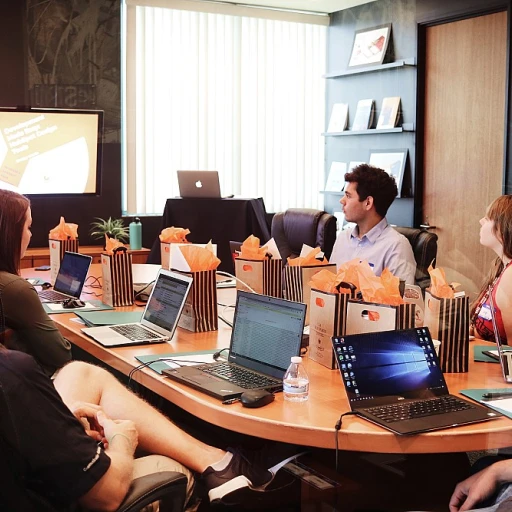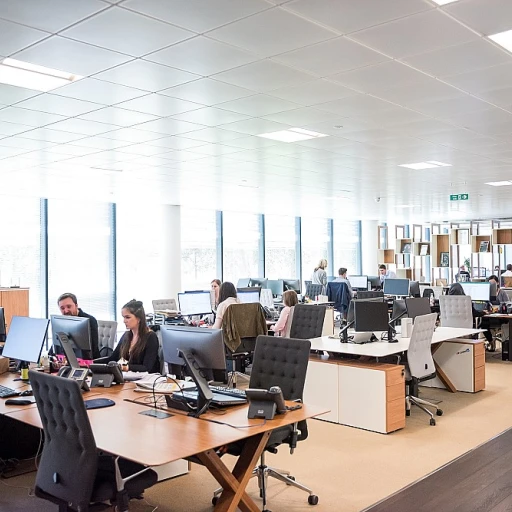Why Work-Life Balance Matters
The Importance of Work-Life Balance
In today's fast-paced world, where the lines between work and personal life are increasingly blurred, achieving a harmonious balance has never been more crucial. The significance of work-life balance extends far beyond merely ensuring employees are content; it is a critical component of creating a healthy, productive workforce that thrives both professionally and personally.
Work-life balance is pivotal as it directly impacts employee well-being, job satisfaction, and overall performance. Businesses that prioritize this balance often see a reduction in turnover rates, enhanced productivity, and improved workplace morale. Employees who feel they have a manageable work-life balance tend to exhibit less stress, better mental health, and increased loyalty to their employers.
Companies that prioritize work-life balance can also expect to attract top talent who value a supportive work environment. In the current job market, where candidates have more options and are increasingly choosing workplaces based on their culture and values, ignoring the importance of work-life balance could be detrimental to an organization's growth.
The role of human resources in facilitating a healthier work-life balance cannot be overstated. By tracking and analyzing the right metrics, HR departments can gain insights into employee needs and identify areas requiring intervention. This process is crucial for developing relevant policies that foster a supportive workplace culture. For those looking to enhance this balance within their organization, implementing these strategies can be a game-changer, as explored in our comprehensive guide on
HR's role in facilitating work-life balance.
As we delve deeper into this series, we'll explore specific HR metrics that are vital for achieving an optimal work-life equilibrium, and how organizations worldwide are setting the benchmark with innovative approaches.
Key HR Metrics to Track
Essential HR Metrics for Evaluating Work-Life Balance
In today's constantly evolving work environment, prioritizing work-life balance has become a critical component of organizational success. As discussed previously, nurturing a harmonious work-life balance not only benefits employees but significantly contributes to an organization's overall productivity and retention rates. In this context, HR professionals must have a comprehensive set of metrics to assess and improve work-life balance effectively.
First and foremost, employee satisfaction and engagement surveys provide invaluable insights into how employees perceive their work-life balance. By analyzing feedback regarding workload, workplace stress levels, and job satisfaction, HR can identify areas of improvement that directly impact employee wellness. Regularly conducting these surveys and taking proactive measures based on the findings ensures that the organization's efforts align with employees' needs.
Turnover rates also offer essential data points. High turnover often signals underlying issues related to poor work-life balance, which may include inflexible schedules or lack of support for personal commitments. Monitoring these trends allows HR to implement strategies that retain talent by fostering an environment where individuals feel valued and supported.
Another meaningful metric is the utilization of employee assistance programs (EAPs). Tracking the usage rates of these programs provides insight into employees' wellbeing and their comfort level in seeking help. If EAP utilization is low despite high reported stress levels, it may indicate a need for increased awareness or destigmatization efforts within the organization.
Leveraging technology, such as productivity and performance tracking systems, can further enhance HR's ability to measure work-life balance. Identifying patterns of overworking or disengagement through data analytics empowers HR to initiate early interventions and provide targeted support.
To gain a more comprehensive understanding and refine your strategies, explore these valuable
tips for HR to enhance work-life balance.
Real-Life Examples from Around the World
Global Reflections on Work-Life Balance Success
In discussing work-life balance, it's crucial to draw from real-life examples, as they provide invaluable lessons and innovative strategies for achieving equilibrium. Across the globe, different companies and cultures are experimenting with unique approaches, each offering a blueprint for how work-life balance can be successfully implemented.
In Scandinavia, companies like Volvo have been trailblazers in adopting a six-hour workday, which reflects positively in employee productivity and satisfaction. By reducing the number of hours spent at work, employees find more time to focus on personal needs and well-being, hence promoting a more balanced lifestyle. This method has shown that when work hours decrease, effectiveness does not necessarily follow suit, oftentimes allowing creativity and efficiency to flourish even more.
Meanwhile, in the United States, some tech companies, like Google, have integrated flexible working hours and remote work as part of their employment policies. These arrangements allow employees to manage personal commitments alongside their professional responsibilities better. The flexibility afforded by such policies has been linked with higher employee morale and improved retention rates, underscoring a symbiotic relationship between work flexibility and job satisfaction.
In Japan, a nation known for its intense work culture, some firms are beginning to implement mandatory vacation days and well-being programs to counteract the negative effects of overwork. These policies are designed to prevent burnout and keep employees engaged and motivated, demonstrating an evolving recognition that health and productivity are inherently interconnected.
To understand these approaches better, a
guide to achieving harmony through mentorship programs can provide further insight into how different organizations foster both professional success and personal fulfillment.
These global examples highlight that there is no one-size-fits-all solution. Instead, these initiatives emphasize the importance of culturally and contextually sensitive approaches, which are essential to truly support and nurture work-life balance across diverse workplaces. As we continue to explore and adapt, the future possibilities for creating workspaces that promote a harmonious lifestyle remain exciting and boundless.
The Role of Flexible Working Hours
Embracing the Advantages of Flexible Working Hours
In the ongoing pursuit of an optimal work-life balance, flexible working hours have emerged as a significant solution for many organizations. By their very nature, flexible working arrangements offer employees the ability to tailor their work schedules to better fit their personal lives, allowing for a more harmonious balance between professional and personal responsibilities.
Flexible working hours can be categorized in several ways, from staggered start and finish times to condensed work weeks or even remote working options. Each of these choices provides a level of autonomy to employees, allowing them to have a greater say in when and where they complete their work tasks. In essence, this flexibility leads to a happier, more motivated workforce, reducing burnout and boosting productivity, which notably aligns with the human resource metrics mentioned earlier.
One of the primary benefits of implementing flexible work schedules is the positive impact on employee satisfaction and retention rates. When workers feel they have a better balance between their work commitments and personal life, their overall job satisfaction tends to increase, leading to a stronger commitment to their employer. Additionally, flexible arrangements can result in lower absenteeism as employees are better able to manage personal obligations without conflicting with work demands.
Moreover, flexible working hours can also be a vital tool in attracting top talent. As work-life balance becomes increasingly crucial for job seekers, organizations that offer flexibility demonstrate a forward-thinking and employee-focused culture. This can be a deciding factor for qualified candidates considering employment offers.
However, the transition to flexible work hours does come with challenges. It requires a cultural shift within the organization, where trust and clear communication between managers and employees are essential. Establishing detailed guidelines and ensuring consistent communication channels are vital in mitigating any potential misunderstandings and ensuring everyone remains aligned with the company's goals.
The potential of flexible working hours is undeniable, and when integrated thoughtfully, they can be a driving force in enhancing work-life balance. As we continue to explore the balance between work and personal life, flexibility remains a pivotal role player in shaping the future of workplaces. As you continue to delve into the nuances of work-life balance, the path forward is paved with opportunities to refine our approaches and maximize the satisfaction and efficiency of the global workforce.
Balancing Work and Personal Life
Integrating Work and Life Seamlessly
Achieving a harmonious balance between work and personal life is a nuanced endeavor that requires intentional effort and strategic planning. As highlighted in earlier sections, the importance of work-life balance cannot be overstated, and HR metrics provide valuable insights into how organizations can support this balance.
One effective strategy is to establish clear boundaries between work and personal time. This can be as simple as setting specific work hours and sticking to them, or it might involve more complex solutions like implementing no-email policies after hours. The key is to ensure that employees have the space to recharge and engage in personal activities without the looming pressure of work tasks.
Creating a Supportive Work Environment
A supportive work environment is crucial for fostering work-life balance. Encouraging open communication and providing resources for stress management can significantly impact employees' ability to balance their responsibilities. Additionally, offering access to mental health resources and promoting a culture of understanding and empathy can make a substantial difference.
Moreover, as discussed in the section on flexible working hours, allowing employees to have a say in their schedules can empower them to manage their time more effectively. This flexibility can lead to increased job satisfaction and productivity, as employees feel more in control of their work-life integration.
Personal Strategies for Balance
On a personal level, employees can adopt various strategies to enhance their work-life balance. Prioritizing tasks, setting realistic goals, and learning to say no are essential skills that can help maintain equilibrium. Additionally, engaging in regular physical activity, pursuing hobbies, and spending quality time with loved ones are vital for personal well-being.
Ultimately, balancing work and personal life is an ongoing process that requires continuous adjustments and a commitment to self-care. By leveraging the insights from HR metrics and fostering a supportive work culture, organizations can play a pivotal role in helping employees achieve a sustainable work-life balance.
The Future of Work-Life Balance
Peering into Tomorrow's Work-Life Equilibrium: Insights into Emerging Trends
As we've explored, the demand for a harmonious work-life balance is driving significant transformations in the workplace. From understanding why work-life balance is crucial, to evaluating pivotal HR metrics and studying global examples, it becomes evident that a sustainable balance is not just a fleeting trend, but a critical component of modern work culture.
Looking ahead, the future promises even greater shifts. Technological advancements, societal changes, and evolving employee expectations are paving the way for innovative solutions that aim to better integrate work responsibilities with personal life priorities.
Technological Progress and Remote Work
One of the most notable developments is the proliferation of remote work. This shift, accelerated by digital innovations, is offering employees unprecedented flexibility, allowing them to craft schedules that accommodate their personal lives more seamlessly. As more companies embrace this trend, we are likely to witness a balanced and empowered workforce.
Furthermore, tools powered by artificial intelligence and automation are transforming how tasks are managed, presenting the opportunity to alleviate workload pressures previously shouldered by humans. By effectively deploying these technologies, organizations can promote efficiency and, most importantly, reduce employee burnout.
Emphasizing Employee Wellness and Mental Health
As companies realize the impact of mental health on productivity, wellness initiatives are increasingly becoming a cornerstone of corporate strategy. Organizations are proactively instigating programs to foster well-being, including proper management of work-related stress.
Experiments with flexible work hours and environments are also anticipated, as these have proven beneficial in previous case studies. This flexibility enables employees to manage their work commitments without compromising on personal priorities, leading to a healthier balance.
In conclusion, as businesses strategize to enhance their work environments, it is crucial for HR departments to remain vigilant and adaptive. By staying abreast of these trends and employing key HR metrics, they can support and empower employees in their journey towards a sustainable work-life balance.
The future holds immense potential and, as these trends evolve, we can expect work-life balance to become an integral part of the conversation around workforce management. The key will be to maintain flexibility, embrace innovation, and steadfastly prioritize employee well-being within organizational strategies.












